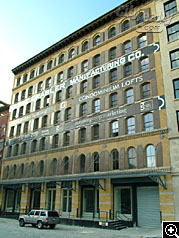New York Historic Districts: Coming Home to History
JANUARY 20, 2012
 Historic blocks, with their unique architecture, help make New York City neighborhoods special--but the benefits of calling an historic district home go beyond aesthetics.
Historic blocks, with their unique architecture, help make New York City neighborhoods special--but the benefits of calling an historic district home go beyond aesthetics.
East 10th Street between Avenues A and B in the East Village is the most recent New York City block to be granted landmark status by the city’s Landmarks Preservation Commission. The block–the first in the neighborhood to be landmarked since 1969—has been virtually unaltered since its stately townhouses and classic tenements were built between 1845 and 1904.
But besides the bragging rights of living in a beautiful area, the landmark designation benefits neighborhood residents in other ways. It tends to enhance property values, so helps protect buyers’ investments in the community. Historic districts also maintain their character, increasing their appeal to current and prospective residents. In addition, the landmark designation means the neighborhood has active community members who are serious about preserving the beauty and character of their neighborhood.
New York City is filled with historic districts, and many neighborhoods–such as TriBeCa–contain several. Restored classic buildings reborn as modern apartment buildings—like the Grabler Building at 44 Laight Street (shown) and Pearline Soap Factory at 414 Washington Street–complement the district’s unique architecture.
If you’re interested in a particular neighborhood, view maps of Manhattan's historic districts here.
ALSO IN NEW YORK CITY INSIDER
- 30 Park Place Vs. The Baccarat Hotel and Residences - JUL 8, 2014
- This Week in NYC Living - JUL 1, 2014
- Notable NYC Neighbors - JUN 26, 2014
- Great NYC Buildings: New in the Heights - JUN 23, 2014
- Notable NYC Neighbors - JUN 20, 2014
- Notable NYC Neighbors - JUN 17, 2014
- Building Vs. Building - JUN 9, 2014
- Notable NYC Neighbors - JUN 6, 2014
- Notable NYC Neighbors - MAY 23, 2014
- Notable NYC Neighbors - MAY 15, 2014
- Great NYC Apartment Buildings: 12 East 13th Street vs. 22 Central Park South - MAY 13, 2014
- Notable NYC Neighbors - MAY 7, 2014
- Notable NYC Neighbors - MAY 1, 2014
- Upping the Architectural Ante in NoHo - APR 22, 2014
- Great NYC Buildings: Brooklyn's Gold Coast Living - APR 15, 2014
- Notable NYC Neighbors - APR 11, 2014
- Building vs. Building - APR 10, 2014
- Notable NYC Neighbors - APR 2, 2014
- This Week in NYC Living - APR 1, 2014
- Notable NYC Neighbors - MAR 26, 2014
- View Articles By Date

 6sqft delivers the latest on real estate, architecture, and design, straight from New York City.
6sqft delivers the latest on real estate, architecture, and design, straight from New York City.
